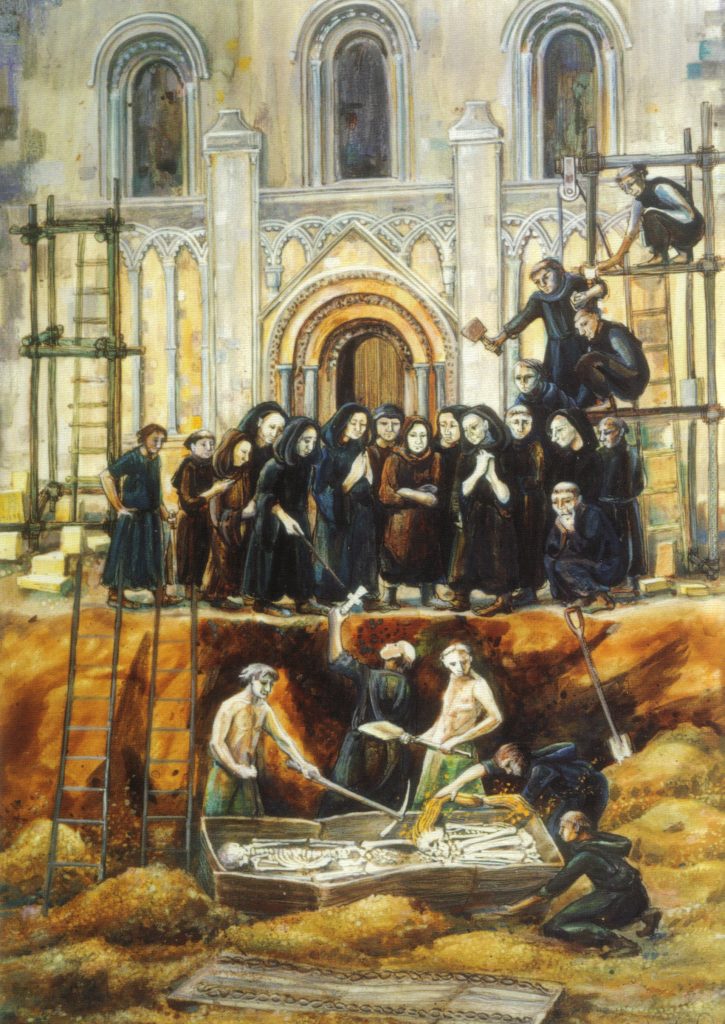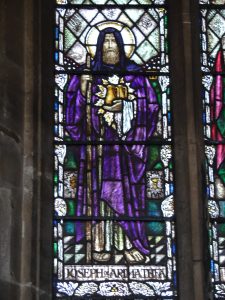 Glastonbury in 1397 is the setting for Joseph of Arimathea’s Treasure, the fifth novel in my Lady Apollonia West Country Mystery Series. This location is rich in legends, particularly in the medieval period. The two figures who are most important in the legends that arose in the medieval period and later are King Arthur and Joseph of Arimathea. Glastonbury Abbey advanced the legends about these men, beginning in the 11th century in the case of King Arthur and especially from the late 12th through the 15th centuries with Joseph of Arimathea.
Glastonbury in 1397 is the setting for Joseph of Arimathea’s Treasure, the fifth novel in my Lady Apollonia West Country Mystery Series. This location is rich in legends, particularly in the medieval period. The two figures who are most important in the legends that arose in the medieval period and later are King Arthur and Joseph of Arimathea. Glastonbury Abbey advanced the legends about these men, beginning in the 11th century in the case of King Arthur and especially from the late 12th through the 15th centuries with Joseph of Arimathea.
In 1191, seven years after the destruction of the abbey by a great fire, Abbot Henry de Sully ordered his monks to dig in the cemetery just south of the Lady Chapel. The result of their work was the discovery of a body which they identified as King Arthur. This exhumation is depicted in the drawing shown above. Note that the Norman Lady Chapel was still under construction. A second body was identified as Guinevere, Arthur’s second wife.
Meanwhile, the abbey sought to rebuild what had been destroyed by fire, and this led to the great Gothic abbey church on the site at the time of my novel. The bones of Arthur and Guinevere were reburied in the new church in 1278 in a ceremony important enough to be attended by King Edward I and Queen Eleanor of England. Obviously, this tomb attracted pilgrims to the abbey and helped contribute to its great wealth.
Glastonbury was viewed by many people in the medieval period as the Isle of Avalon. Although it is not actually an island, the town and its Tor is on a peninsula which rises out of the Somerset Levels like an island. This contributed to the legend of King Arthur in Glastonbury. After the Dissolution of the monasteries by King Henry VIII, the tomb was destroyed. Today, there is a sign in the grassy area where the quire once stood which indicates that the tomb of King Arthur and Queen Guinevere once resided there.
For more on the legends of King Arthur, click on
http://www.britainexpress.com/Myths/Glastonbury_King_Arthur.htm or on
http://www.britannia.com/history/arthur/abbey4.html .
Joseph of Arimathea was a disciple of Christ who made his cave-tomb available to house the dead body of Jesus after the Crucifixion. There are extensive legends concerning Joseph of Arimathea making visits to England and Glastonbury. The most basic is that he came after the Resurrection bringing the Holy Grail. The Chalice Well near the Tor is involved in this legendary story. The red colour which springs forth from this well is attributed to the blood of the Christ brought in the Holy Grail. A variation has Joseph bringing two cruets, one containing blood of Jesus, another containing his sweat as shown in the picture on the right which is one of the stained-glass windows in Saint John the Baptist parish church in Glastonbury that tell the legends of Joseph of Arimathea.
Another feature of the basic legend has arisen in recent centuries. It says that Joseph stood resting on Wearyall Hill on the southwest edge of Glastonbury. When he brought down his staff hard onto the earth, it suddenly bloomed, becoming a hawthorn, which blooms every Christmas and May and sometimes in between. The so-called Glastonbury Thorn is still part of modern folk-culture. It has been featured on a British postage stamp, and a sprig of flowers from it is sent to the Queen of England every Christmas. The Glastonbury Thorn on Wearyall Hill has been vandalised in recent years but copies of it are to be found in the abbey grounds and in front of the parish church of Saint John the Baptist as well as by the abbey tithe barn.
There are other legends about Joseph of Arimathea. One is that he was the uncle of the Virgin Mary and brought his teenage nephew, Jesus, to Glastonbury. We know that ancient peoples from the Mediterranean area got to Cornwall with the tin trade. If someone sailed to Cornwall at that time, Glastonbury could also be reached by ship. At high tide, the Bristol Channel reached all the way to Glastonbury. This was before the Romans and the medieval monks began reclaiming vast areas of Somerset from the sea. In Joseph’s time, such a voyage was feasible.
Another Joseph legend is that he led the first missionaries in bringing Christianity to Britain around 63 AD. The abbots of Glastonbury used this story to enhance their claim to be the first monastery in England. At the time of my story and in the next century, they were promoting some of these legends. There is a well in the crypt of the Lady Chapel which was renamed Joseph’s Well, and I have used that well in my story.
For more on the legends about Joseph of Arimathea, click on
https://en.wikipedia.org/wiki/Joseph_of_Arimathea or on
http://www.glastonburyabbey.com/joseph_of_arimathea.php or on
http://www.bbc.co.uk/thepassion/articles/joseph_of_arimathea.shtml .
Tags: Chaucer's England, historical fiction, medieval mysteries